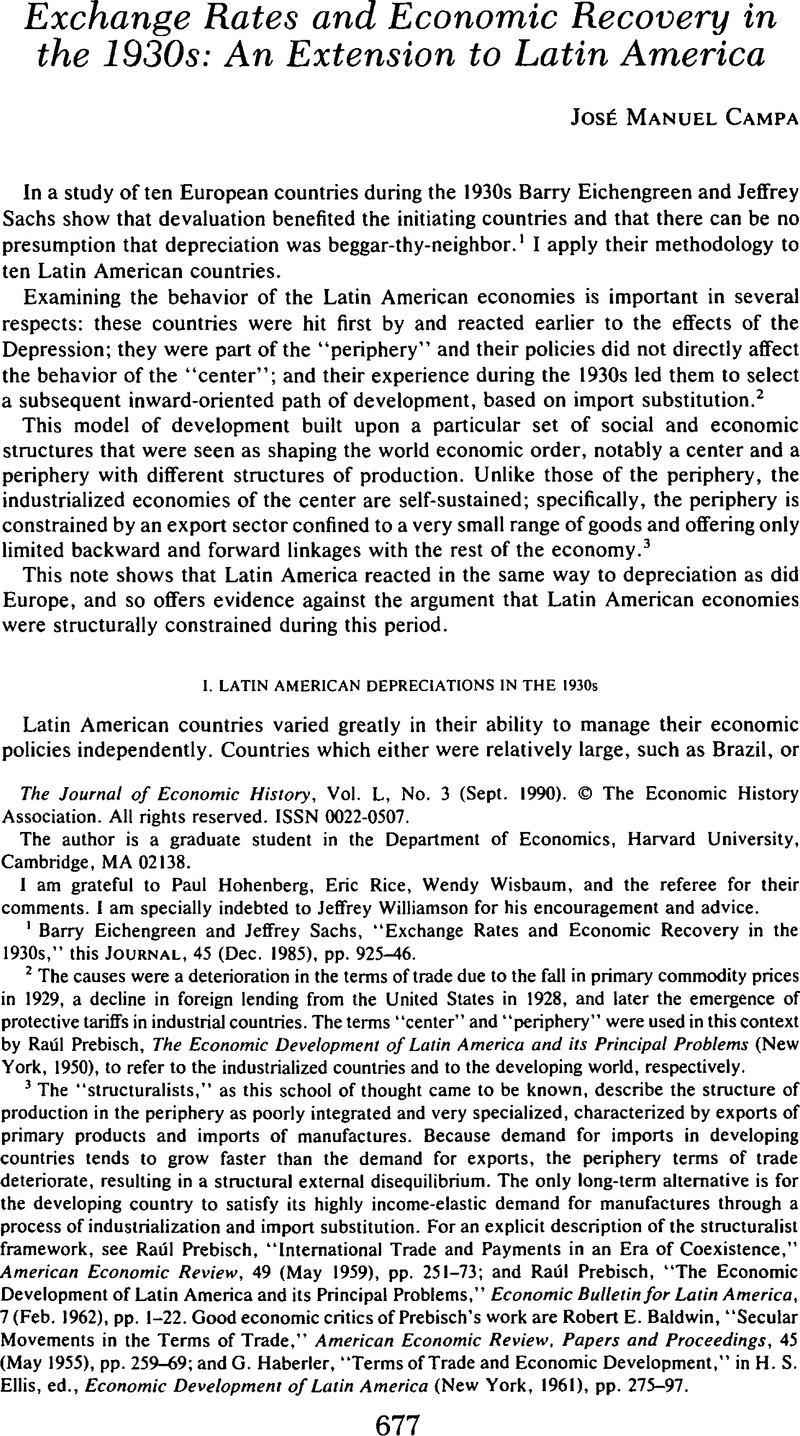Article contents
Exchange Rates and Economic Recovery in the 1930s: An Extension to Lation America
Published online by Cambridge University Press: 03 March 2009
Abstract

- Type
- Notes and Discussion
- Information
- Copyright
- Copyright © The Economic History Association 1990
References
1 Eichengreen, Barry “Exchange Rates and Economic Recovery in the 1903s” this JOURNAL, 45 (12. 1985), pp. 925–46Google Scholar
2 The causes were a deterioration in the terms of trade due to the fall in primary commodity prices in 1929, a decline in foreign lending from the United States in 1928, and later the emergence of protective tariffs in industrial countries. The terms “center” and “periphery” were used in this context by Prebisch, Raúl, The Economic Development of Latin America and its Principal Problems (New York, 1950), to refer to the industrialized countries and to the developing world, respectively.Google Scholar
3 The “structuralists,” as this school of thought came to be known, describe the structure of production in the periphery as poorly integrated and very specialized, characterized by exports of primary products and imports of manufactures. Because demand for imports in developing countries tends to grow faster than the demand for exports, the periphery terms of trade deteriorate, resulting in a structural external disequilibrium. The only long-term alternative is for the developing country to satisfy its highly income-elastic demand for manufactures through a process of industrialization and import substitution. For an explicit description of the structuralist framework, see Prebisch, Raúl, “International Trade and Payments in an Era of Coexistence,” American Economic Review, 49 (05 1959), pp. 251–73;Google Scholar and Prebisch, Raúl, “The Economic Development of Latin America and its Principal Problems,” Economic Bulletin for Latin America, 7 (02 1962), pp. 1–22.Google Scholar Good economic critics of Prebisch's work are Baldwin, Robert E., “Secular Movements in the Terms of Trade,” American Economic Review, Papers and Proceedings, 45 (05 1955), pp. 259–69;Google Scholar and Haberler, G., “Terms of Trade and Economic Development,” in Ellis, H. S., ed., Economic Development of Latin America (New York, 1961), pp. 275–97.CrossRefGoogle Scholar
4 Díaz-Alejandro, Carlos, “Latin America in the 1930s.” in Thorp, Rosemary, ed., Latin America in the 1930s, The Role of the Periphery in World Crisis (Oxford, 1984), chap. 2.Google Scholar
5 One may conjecture that these were not important, real depreciations. It is fair to say that Central America followed a passive exchange-rate policy because even in the countries where the exchange rate was allowed to float, Costa Rica and El Salvador, it did not change very dramatically. See Victor Bulmer-Thomas, “Central America in the Inter-War Period,” in Thorp, Latin America in the 1930s, p. 289.Google Scholar
6 For a more detailed explanation of the different exchange-rate regimes applicable in each country, see League of Nations Economic Intelligence Service, Monetary Review (Geneva, 1937).Google Scholar
7 See Mundell, Robert, “Capital Mobility and Stabilization Policy under Fixed and Flexible Exchange Rates,” Canadian Journal of Economics and Political Science, 29 (11. 1963), pp. 475–85;CrossRefGoogle Scholar and Fleming, J. Marcus, “Domestic Financial Policies under Fixed and under Floating Exchange Rates,” International Monetary Fund Staff Papers, 9 (11. 1962), pp. 369–79.CrossRefGoogle Scholar
8 A devaluation is sterilized when the depreciating country adjusts its money supply in order to leave unchanged the ratio of gold backing to money in circulation.Google Scholar
9 This small-country assumption seems realistic since all of these countries were part of the periphery.Google Scholar
10 There is a general agreement that the import-substitution policies followed by the governments of the Latin American countries as an answer to the Depression were basically correct. These policies did not come from an existing theoretical framework but were the reaction to enormous macroeconomic imbalances. For a better description of the general policies, see Díaz-Alejandro, “Latin America in the 1930s.” For a detailed description of individual countries' policies, see Maddison, Angus, Two Crises: Latin America and Asia, 1929–38 and 1973–83 (Washington, DC, 1985), pp. 23–32.Google Scholar
11 A depreciation is expressed as the gold price of domestic currency in 1935 as a percentage of the 1929 parity. A value of 69 for Argentina indicates a 31 percent depreciation. Industrial production is the ratio of the production index in 1935 to that of 1929 multiplied by 100.Google Scholar
12 El Salvador is a special case in the sense that it suffered a 17 percent reduction in industrial production in spite of an almost 20 percent depreciation. This was probably caused by the government's decision to keep promoting coffee production despite the drop in coffee prices. A more detailed exposition of the policies followed by the Salvadorian government in this period can be found in Wilson, E. A., “The Crisis of National Integration in El Salvador, 1919–35” (Ph.D. dissertation, Stanford University, 1970).Google Scholar
13 These regressions reproduce equations 1 and 5 in table 3 of their paper.Google Scholar
- 34
- Cited by


